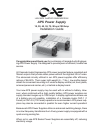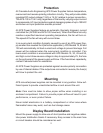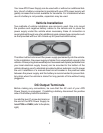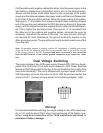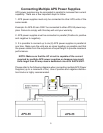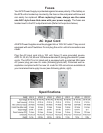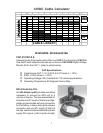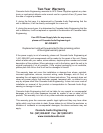Protection
All Cascade Audio Engineering APS Power Supplies feature temperature,
overcurrent and reverse-polarity protection circuitry. They will provide stable
regulated DC output voltage (13.6V or 14.2V, relative to jumper connection -
The APS-100 is 13.4V only) regardless of the load by varying output current
to compensate. AC input protection against damaging spikes of up to 190VAC
and brown-out input protection are also provided.
All APS Power Supplies feature an automatic, thermally triggered, current
controlled fan (APS-90 and APS-100 have two). When the internal circuitry
reaches a specified maximum operating temperature, the fan will turn on.
The speed of the fan will vary with current draw.
In an overcurrent condition (typically caused by use of an APS power Sup-
ply smaller than needed for a particular application), APS Models 75, 90 and
100 will automatically roll back current and voltage to prevent damage. Full
power will be restored when the overcurrent condition is corrected. If an
overcurrent condition is encountered with APS Models 15, 30, 45 and 55,
and high current draw causes voltage to drop to approximately 2V, the fuse
on the end panel of the power supply will blow. If the fuse blows repeatedly,
contact Cascade Audio for assistance.
All APS Power Supplies are protected against reverse-polarity connection
by use of internal diodes. If the outputs are connected in reverse, the fuse(s)
will blow to protect the unit.
Mounting
APS converter/power supplies can be mounted in any position. Allow suf-
ficient space to provide unrestricted airflow in and around the unit.
Note: Care must be taken to allow proper airflow when installing in an
enclosed compartment. Failure to provide proper airflow will result in poor
performance, or even product failure.
Never install electronics in a battery compartment or other area where
flammable fumes may exist, such as fuel storage areas.
Display Board Installation
Mount the power supply to allow use of short positive and negative cables.
Use power distribution blocks if necessary. Easy access to the main fuse
or circuit breaker should be considered as well.
2



